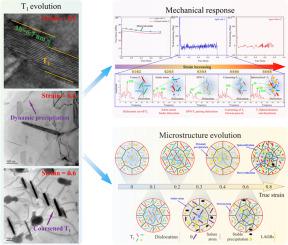当前位置:
X-MOL 学术
›
Int. J. Plasticity
›
论文详情
Our official English website, www.x-mol.net, welcomes your feedback! (Note: you will need to create a separate account there.)
Dynamic evolution of the T1 phase and its effect on continuous dynamic recrystallization in Al–Cu–Li alloys
International Journal of Plasticity ( IF 9.8 ) Pub Date : 2024-03-17 , DOI: 10.1016/j.ijplas.2024.103948 Kuizhao Wang , Cunsheng Zhang , Zinan Cheng , Haibin Zhao , Zijie Meng , Liang Chen , Guoqun Zhao
International Journal of Plasticity ( IF 9.8 ) Pub Date : 2024-03-17 , DOI: 10.1016/j.ijplas.2024.103948 Kuizhao Wang , Cunsheng Zhang , Zinan Cheng , Haibin Zhao , Zijie Meng , Liang Chen , Guoqun Zhao

|
The T phase is the highest density and most prominent strengthening effect precipitate in Al–Cu–Li alloys, and it undergoes a complex dynamic evolution during hot deformation, which has significant effects on microstructure development and hot working. This study comprehensively characterizes and analyzes the dynamic evolution of the T phase at 400 °C/0.01 s and its influence on continuous dynamic recrystallization (CDRX). The results indicate that the T phase successively undergoes coarsening, fracture, dissolution, dynamic precipitation, recoarsening, and spheroidization during deformation. A shear-coupled diffusion mechanism is proposed to explain the ultrafast coarsening rate of the T phase in early deformation. During the dynamic precipitation of the T phase, an anomalous inhomogeneous size and spatial distribution of the T phase are observed, and a high number density of fine T phases form in the matrix (with a denser, thinner and shorter size at the dislocation wall). The dynamically precipitated T phase is affected by the octahedral slip system during the coarsening process and exhibits a selective ripening phenomenon. The T phase formed by aging increases the inhomogeneity of the deformation and induces many substructures intragranularly, decreasing the percentage of CDRX grains but increasing the CDRX potential. Conversely, the dynamically precipitated T phase and its evolution accelerate CDRX development by promoting the transformation of LAGBs to HAGBs. In addition, the effects of dynamically evolving precipitates on the dislocations and formation modes of LAGBs at various deformation stages are elucidated. The results can provide valuable insights into the regulation of microstructure, and the development of high-performance Al–Cu–Li alloys, and also offer a theoretical and experimental basis for microstructure modeling.
中文翻译:

Al-Cu-Li合金中T1相的动态演化及其对连续动态再结晶的影响
T相是Al-Cu-Li合金中密度最高、强化效果最显着的析出相,在热变形过程中经历复杂的动态演化,对显微组织发展和热加工具有重要影响。本研究全面表征和分析了 400 °C/0.01 s 下 T 相的动态演化及其对连续动态再结晶 (CDRX) 的影响。结果表明,T相在变形过程中依次经历粗化、断裂、溶解、动态析出、再粗化和球化。提出了剪切耦合扩散机制来解释早期变形中 T 相的超快粗化速率。在T相的动态析出过程中,观察到T相的尺寸和空间分布异常不均匀,基体中形成高数密度的细小T相(位错壁处的尺寸更密、更薄、更短) 。动态析出的T相在粗化过程中受到八面体滑移系的影响,表现出选择性熟化现象。时效形成的T相增加了变形的不均匀性,并在晶内诱导出许多亚结构,降低了CDRX晶粒的百分比,但增加了CDRX电势。相反,动态沉淀的 T 期及其演化通过促进 LAGB 向 HAGB 的转变,加速了 CDRX 的发展。此外,还阐明了动态演化的析出物对不同变形阶段的LAGB位错和形成模式的影响。研究结果可为微观结构的调控和高性能Al-Cu-Li合金的开发提供有价值的见解,并为微观结构建模提供理论和实验基础。
更新日期:2024-03-17
中文翻译:

Al-Cu-Li合金中T1相的动态演化及其对连续动态再结晶的影响
T相是Al-Cu-Li合金中密度最高、强化效果最显着的析出相,在热变形过程中经历复杂的动态演化,对显微组织发展和热加工具有重要影响。本研究全面表征和分析了 400 °C/0.01 s 下 T 相的动态演化及其对连续动态再结晶 (CDRX) 的影响。结果表明,T相在变形过程中依次经历粗化、断裂、溶解、动态析出、再粗化和球化。提出了剪切耦合扩散机制来解释早期变形中 T 相的超快粗化速率。在T相的动态析出过程中,观察到T相的尺寸和空间分布异常不均匀,基体中形成高数密度的细小T相(位错壁处的尺寸更密、更薄、更短) 。动态析出的T相在粗化过程中受到八面体滑移系的影响,表现出选择性熟化现象。时效形成的T相增加了变形的不均匀性,并在晶内诱导出许多亚结构,降低了CDRX晶粒的百分比,但增加了CDRX电势。相反,动态沉淀的 T 期及其演化通过促进 LAGB 向 HAGB 的转变,加速了 CDRX 的发展。此外,还阐明了动态演化的析出物对不同变形阶段的LAGB位错和形成模式的影响。研究结果可为微观结构的调控和高性能Al-Cu-Li合金的开发提供有价值的见解,并为微观结构建模提供理论和实验基础。



























 京公网安备 11010802027423号
京公网安备 11010802027423号